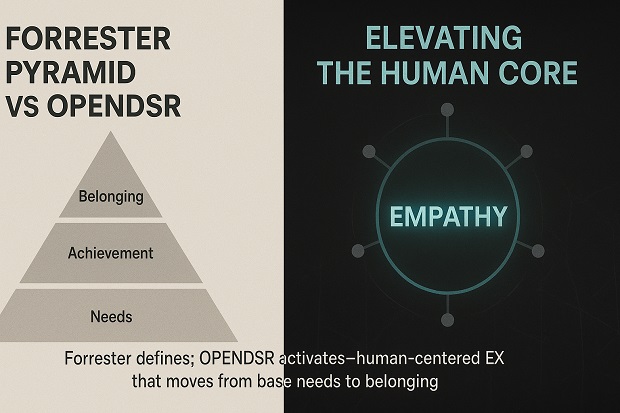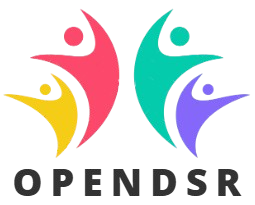
Forrester EX Pyramid vs OPENDSR: Elevating the Human Core
Forrester EX Pyramid vs OPENDSR: Elevating the Human Core From Defining Experience to Activating Human-Centered Design 1. Introduction: The Shift from Hierarchies to Human Systems
Employee Experience (EX) has evolved from an HR initiative to a business differentiator — shaping culture, customer loyalty, and organizational agility. Two frameworks stand tall in guiding this transformation:
Forrester’s Employee Experience Pyramid and OPENDSR’s Human-Centered Experience (HCX) Framework.
-
Forrester’s EX Pyramid defines the hierarchy of employee needs — a structured, diagnostic model that explains what drives satisfaction and engagement.
-
OPENDSR, on the other hand, is an activation framework — turning these needs into living systems that sense, design, and adapt in real time.
This article explores how Forrester defines the human experience, while OPENDSR activates it — translating the static pyramid into a circular, empathetic, and intelligent design cycle that elevates both individual and organizational growth.
Metaphorically: Forrester builds the blueprint of needs; OPENDSR builds the engine of empathy.
2. Understanding Forrester’s EX Pyramid 2.1 The Foundation of the ModelForrester’s Employee Experience (EX) Pyramid, inspired by Maslow’s hierarchy, redefines what employees truly need from their organizations to deliver exceptional performance. It focuses on three ascending layers:
-
Functional Needs – the foundational layer ensuring that employees have the tools, clarity, and processes to do their work effectively.
-
Emotional Needs – the middle layer where employees seek recognition, respect, and psychological safety.
-
Meaningful Needs – the apex, where employees connect their work to purpose, belonging, and contribution.
Forrester posits that organizations often invest heavily in functional enablement (technology, process) but neglect the emotional and meaningful layers, which actually drive long-term engagement, advocacy, and retention.
Their research consistently shows that employees who experience both emotional connection and meaningful work are 4.4x more likely to go above and beyond in their roles.
In Forrester’s logic, EX excellence = functional + emotional + meaningful alignment.
3. Strengths and Gaps in Forrester’s Pyramid 3.1 Strengths-
Provides a clear, intuitive model for diagnosing EX maturity.
-
Highlights emotional and purposeful dimensions often ignored in traditional HR metrics.
-
Aligns with both employee psychology and organizational behavior research.
Despite its conceptual clarity, the Pyramid often stays diagnostic, not design-oriented.
Organizations understand what to fix but struggle with how to transform.
This is where OPENDSR enters — not as a competing model but as a dynamic design layer that brings the Forrester Pyramid to life.
4. Enter OPENDSR: The Activation Framework for Human-Centered Experience 4.1 What is OPENDSR?OPENDSR (Observe, Prioritize, Envision, Navigate, Design, Systematize, Refine) is a 7-step Human-Centered Experience framework built to turn employee insights into continuous organizational learning and action.
It blends empathy-led exploration with data-driven refinement, ensuring that the human experience is both felt and sustained.
While Forrester’s Pyramid explains what people need, OPENDSR defines how organizations deliver it — systematically, empathetically, and in real time.
5. Forrester EX Pyramid vs OPENDSR: Conceptual Comparison Aspect Forrester EX Pyramid OPENDSR Framework Integration Insight Purpose Define hierarchy of EX needs Operationalize experience design Converts theory into action Structure Linear hierarchy (base to apex) Circular cycle (continuous refinement) Transforms static hierarchy into dynamic evolution Focus Area Employee sentiment & motivation Systemic design & adaptation Adds design and feedback layer Measurement Survey-driven insights Behavioral, real-time feedback Enhances data depth and immediacy Application Diagnostic tool Design framework Complements for activation Temporal Scope Periodic Ongoing Ensures continuous engagement Output Reports, heatmaps, maturity levels Prototypes, experience maps, governance systems Moves from awareness to movement 6. The Activation Bridge: Turning Forrester’s Pyramid into MotionLet’s now explore how each level of the Forrester Pyramid is activated through the OPENDSR 7-step cycle.
Forrester Level Mapped OPENDSR Steps Example Actions Resulting Outcomes Functional Needs Observe → Prioritize → Design Conduct workflow observations, identify friction points, co-design productivity enablers Seamless digital experiences; employees feel enabled Emotional Needs Observe → Navigate → Refine Use empathy mapping, listening tours, manager feedback loops Strengthened belonging and psychological safety Meaningful Needs Envision → Systematize → Refine Co-create purpose-driven rituals, integrate value-based recognition systems Sustained connection to purpose and mission Example in PracticeImagine a financial services firm using Forrester’s model as their diagnostic baseline:
-
Their EX survey shows high “Functional” but low “Meaningful” scores.
-
Through OPENDSR, they launch:
-
Observe: Employee storytelling sessions about “why they joined.”
-
Envision: Purpose workshops connecting personal goals to company mission.
-
Design: Purpose-aligned performance review templates.
-
Refine: Monthly narrative pulse checks.
-
Within six months, the organization sees not only improved engagement but also measurable boosts in retention, collaboration, and advocacy.
Metric Before (Forrester Diagnosis) After (OPENDSR Activation) Change Meaningful Work Score 64% 83% +19% Voluntary Attrition 13% 8% -5% Employee Net Promoter Score (eNPS) +12 +47 +35 Innovation Suggestion Rate 1 idea/quarter 1 idea/month +300% 7. Beyond Hierarchy: From Pyramid to NetworkThe Forrester Pyramid implies a hierarchy of needs — one must achieve functional enablement before emotional and meaningful connections can thrive.
OPENDSR, however, replaces the hierarchy with a circular empathy network — all layers coexist and continuously reinforce one another.
Forrester organizes EX.
OPENDSR orchestrates EX.
Visually, this can be represented as a split image:
-
Left: Forrester’s pyramid — structured layers from base (functional) to top (meaningful).
-
Right: OPENDSR’s circular cycle — glowing empathy nodes connected through feedback loops.
This transition signifies a shift from hierarchy to harmony.
8. Human-Centered Experience: Where the Models ConvergeBoth frameworks share a profound belief:
The heart of organizational success lies in human experience — not policy compliance.
Dimension Forrester OPENDSR Synthesis Human Motivation Defines needs Captures signals Understands intent Empathy Thematic lens Structural driver Operational empathy Purpose Recognized at the top Embedded at every step Purpose as living design principle Leadership Role Create conditions Model experience Leadership by design Measurement Experience maturity Experience proficiency Aligns metrics with meaningThrough integration, organizations can move beyond annual EX assessments to live ecosystems where employee sentiment instantly triggers design improvements — creating workplaces that listen, adapt, and evolve daily.
9. Real-World Application: Case Study ContextA mid-sized tech company adopted Forrester’s EX Pyramid to diagnose engagement gaps. Their surveys showed:
-
Strong functional enablement (tools, clarity).
-
Weak emotional connection (recognition, inclusion).
-
Poor meaning alignment (employees unaware of company mission).
OPENDSR also introduces new EX governance roles that help sustain the activation layer Forrester’s model inspires:
Role Function Link to Forrester Layer EX Owner Oversees experience outcomes across journeys Functional–Emotional HCX Data Steward Ensures ethical, continuous EX data use Functional Moment Designer Crafts and iterates high-impact employee moments Emotional–Meaningful EX Council Governs design standards and insights All layersThese roles ensure the human core stays operational — not aspirational.
11. The Philosophical Evolution: From Experience to ExistenceForrester’s model elevates EX to a strategic imperative.
OPENDSR turns it into a living operating system.
In the age of AI, automation, and algorithmic decision-making, reclaiming the human core is not a moral luxury — it’s a strategic necessity.
Employees don’t just want efficient tools; they crave empathetic ecosystems that understand and evolve with them.
Forrester’s EX Pyramid defines human needs.
OPENDSR ensures the organization behaves humanly.
The future of EX lies at the intersection of clarity and compassion, definition and design, insight and iteration.
Forrester’s EX Pyramid gave organizations a lens to see what matters to employees.
OPENDSR gives them a language and mechanism to respond meaningfully — every day, in every interaction.
The pyramid builds structure.
The circle builds life.
Together, they redefine what it means to be human at work — not as a layer in a model, but as the living center of every organizational system.








